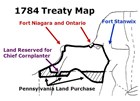The history of Fort Stanwix, from first contact through the end of the fort's useful military life, symbolizes the broader contest of nations (European, United States and American Indian) for economic and political control of the Oneida Carrying Place, the Mohawk Valley, the homelands of the Six Nation Confederacy, and the rich resources of North America. The following web pages focus on treaties and land transactions negotiated and concluded at Fort Stanwix.
-
Fort Stanwix National Monument
Article 1: Treaties of the Fort

The history of Fort Stanwix, from first contact through the end of the fort's useful military life, symbolizes the broader contest of nations (European, United States and American Indian) for economic and political control of the Oneida Carrying Place, the Mohawk Valley, the homelands of the Six Nation Confederacy, and the rich resources of North America. Read more
-
Article 2: 1768 Boundary Line Treaty of Fort Stanwix

Nicknamed "the Fort Stanwix Land Lottery and Sweepstakes Treaty" by James H. Merrill in his book Into the American Woods: Negotiations on the Pennsylvania Frontier, the 1768 Boundary Line Treaty of Fort Stanwix was controversial before the ink dried on the parchment on November 2. Read more
-
Fort Stanwix National Monument
Article 3: Treaty and Land Transaction of 1784

The American Revolutionary War in states such as New York, and North and South Carolina was brutal. This is because of the nature of the wars fought in these states. The wars fought in these states were civil wars. The colonial/state citizens as well as members of the American Indian nations chose sides fought against each other. Years of pent up animosities were unleashed on each other. Read more
-
Fort Stanwix National Monument
Article 4: State of New York Treaties and Land Transactions with the Oneida, Onondaga, and Cayuga

Less than a year after the 1784 Treaty of Fort Stanwix was concluded the State of New York began negotiating a series of treaties and land transactions with the Oneida, Tuscarora, Onondaga and Cayuga Nations. Read more
-
Article 5: Tree of Peace
Traditional Mohawk Chief Jake Swamp created the Tree of Peace Society in 1982 to commemorate the Great Law of Peace. His organization planted White Pines all over the country. On April 29, 1988, the Iroquois returned to Philadelphia to plant a White Pine by the First Bank of the United States. Read more

